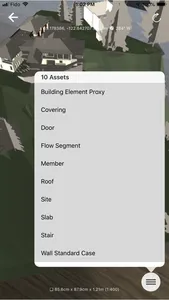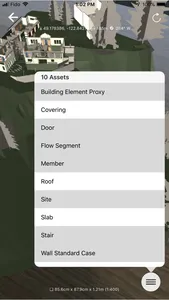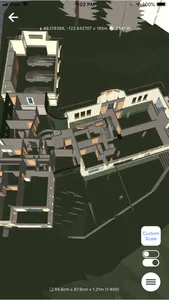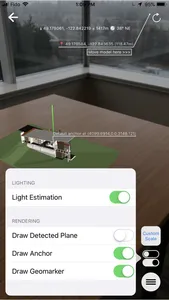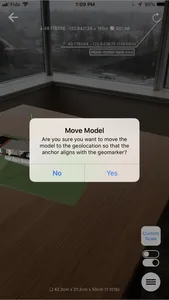This app allows FME users to easily create unparalleled augmented reality experiences for iPhone and iPad. It has an accurate tracking of device movement. It can analyze the scene presented by the camera view and find horizontal planes in the real world. It can place and track virtual objects on the planes with a high degree of accuracy without additional calibration. With the presence of LiDAR from recent iPhone Pro and iPad Pro, this app is able to quickly detect the topology of the physical environment and improve placement of the virtual objects.
This app supports the newest FME AR Writer in FME 2021.2+ and is able to render the more realistic USDZ models as well as OBJ models created with the previous version of FME AR Writer. The Writer can create georeferenced 3D models in the custom FME AR format with a file extension .fmear. This app can then open those files from cloud storages such as iCloud Drive and Dropbox, or from email attachments or AirDrop.
FME users can also define one or more viewpoints for a model, and the viewpoints will be labeled in the app. The users can then virtually "teleport" to different viewpoints easily.
The output models from the FME AR Writer by default are displayed to Fit within the screen, however the user can specify a Custom Scale or set it to Full Scale. The app is able to display a model in real-life size, and the users can even "walk inside" the model.
Device requirements
Most iOS devices from the past 5 years are able to run FME AR. The followings are the specific devices:
iPhone 6, 7, 8 series
iPhone X, Xs, Xr series
iPhone 11, 12, 13 series
iPhone SE
iPad Pro
iPad (2017 or later)
For details, please visit: Augmented Reality for iOS: Making 3D models for ARKit with FME | Safe Software
Instructions
Cloud Storage Access
FME AR model can be streamed to FME AR app from FME Data Express, loaded from the device internal storage or from a Cloud Storage. To enable access to Cloud Storage, specific cloud storage apps (e.g. DropBox or OneDrive) need to be installed on the device.
Surface Detection
A surface with some textures is better than a surface with a solid colour. You may need to slightly tilt and move your device so that it can detect the surface. When a surface is detected, a yellow square will be shown.
Geolocation: Anchor
An FME AR file can optionally specify an anchor (the position in the world, specified in LL84) where the model should be placed when viewing as geolocated.
In FME workspace, an Anchor definition can be carried by any feature, with or without geometry. Anchor is defined using three FME AR format attributes:
fmear_location_feature set to anchor
fmear_anchor_latitude set to anchor latitude in LL84
fmear_anchor_longitude set to anchor longitude in LL84
By default, the Anchor is located in the middle of the model at elevation 0. If the anchor feature has a Point geometry in model coordinates, coordinates of the Point will be used to specify scene coordinates to which the latitude and longitude map.
Teleporting: Viewpoints
In order to be able to easily jump between different points within a large model, an FME AR file may contain a number of Viewpoints, which, when viewed with a supported app, allow users to recenter the view on them.
In FME workspace, a Viewpoint is defined by a feature with Point geometry in model coordinates with format attribute fmear_location_feature set to viewpoint. A Viewpoint name can be set by specifying Geometry Name on the Point geometry using GeometryPropertySetter transformer.
Model Expiry
An FME AR model can have an expiration date. When the model is loaded past its expiry, a warning will be displayed in the app.
In FME workspace, to set a model expiration date, FME AR Writer needs to receive a feature with fmear_model_expiry format attribute set to a value in FME datetime format, e.g. 20210906111730.135-08:00.
This app supports the newest FME AR Writer in FME 2021.2+ and is able to render the more realistic USDZ models as well as OBJ models created with the previous version of FME AR Writer. The Writer can create georeferenced 3D models in the custom FME AR format with a file extension .fmear. This app can then open those files from cloud storages such as iCloud Drive and Dropbox, or from email attachments or AirDrop.
FME users can also define one or more viewpoints for a model, and the viewpoints will be labeled in the app. The users can then virtually "teleport" to different viewpoints easily.
The output models from the FME AR Writer by default are displayed to Fit within the screen, however the user can specify a Custom Scale or set it to Full Scale. The app is able to display a model in real-life size, and the users can even "walk inside" the model.
Device requirements
Most iOS devices from the past 5 years are able to run FME AR. The followings are the specific devices:
iPhone 6, 7, 8 series
iPhone X, Xs, Xr series
iPhone 11, 12, 13 series
iPhone SE
iPad Pro
iPad (2017 or later)
For details, please visit: Augmented Reality for iOS: Making 3D models for ARKit with FME | Safe Software
Instructions
Cloud Storage Access
FME AR model can be streamed to FME AR app from FME Data Express, loaded from the device internal storage or from a Cloud Storage. To enable access to Cloud Storage, specific cloud storage apps (e.g. DropBox or OneDrive) need to be installed on the device.
Surface Detection
A surface with some textures is better than a surface with a solid colour. You may need to slightly tilt and move your device so that it can detect the surface. When a surface is detected, a yellow square will be shown.
Geolocation: Anchor
An FME AR file can optionally specify an anchor (the position in the world, specified in LL84) where the model should be placed when viewing as geolocated.
In FME workspace, an Anchor definition can be carried by any feature, with or without geometry. Anchor is defined using three FME AR format attributes:
fmear_location_feature set to anchor
fmear_anchor_latitude set to anchor latitude in LL84
fmear_anchor_longitude set to anchor longitude in LL84
By default, the Anchor is located in the middle of the model at elevation 0. If the anchor feature has a Point geometry in model coordinates, coordinates of the Point will be used to specify scene coordinates to which the latitude and longitude map.
Teleporting: Viewpoints
In order to be able to easily jump between different points within a large model, an FME AR file may contain a number of Viewpoints, which, when viewed with a supported app, allow users to recenter the view on them.
In FME workspace, a Viewpoint is defined by a feature with Point geometry in model coordinates with format attribute fmear_location_feature set to viewpoint. A Viewpoint name can be set by specifying Geometry Name on the Point geometry using GeometryPropertySetter transformer.
Model Expiry
An FME AR model can have an expiration date. When the model is loaded past its expiry, a warning will be displayed in the app.
In FME workspace, to set a model expiration date, FME AR Writer needs to receive a feature with fmear_model_expiry format attribute set to a value in FME datetime format, e.g. 20210906111730.135-08:00.
Show More

